Tag Archive: myths
September 10, 2020
by Carole Zangari -
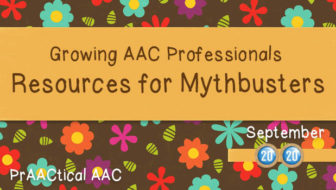
We’re excited to have another guest post today by Vicki Haddix, an AAC SLP and Clinical Assistant Professor at the University of Memphis. Vicki joins us periodically to share some of the work completed by her SLP graduate students. Under her leadership, they create videos, handouts, and other materials that can be used by families, clinicians, and educators. Let’s take a look. ::::::::::::::::::::::::::::::::::::::::::::::::::::::::::::::::::::::::::::::::::::::::::::::::::::::::::::::: As I have said in previous posts about teaching the graduate class on AAC, I find Universal Design for Learning (UDL) to be a very helpful framework when designing the course, although I’ve realized I don’t typically name UDL when I discuss activities or assignments. But I was thrilled when Lindsey Hull came to me wanting to look at integrating students who use AAC within the general education classroom, and we got to talk about UDL. She put together a narrated PowerPoint full of great ideas for... [Read More...]
Filed under: Featured Posts, PrAACtical Thinking
Tagged With: & Tools, Checklists, forms, myths, videos, visual supports
October 31, 2013
by Robin Parker -
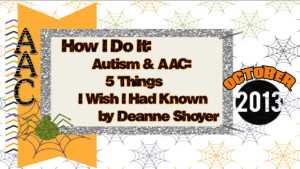
We are so pleased to have connected with Deanne Shoyer from Small But Kinda Mighty and even happier that she is our guest blogger today. Deanne is a mom of twin boys who both are on the autism spectrum. Deanne successfully fundraised to buy iPads for her boys and has been active for more than 3 years in social media and in the special needs app community. She has written about many things but often focuses on implementing AAC in a very PrAACtical way. Please feel free to share this very important post as she highlights AAC, what she has learned, and how it may help others. by Deanne Shoyer at Small But Kinda Mighty (original post at Small But Kinda Mighty) In the title of this post I’ve linked autism and AAC for a specific reason. A lot of the points here are equally applicable to people who have a... [Read More...]
Filed under: PrAACtical Thinking
Tagged With: AAC Resources, Deanne Shoyer, myths
May 31, 2013
by Carole Zangari -
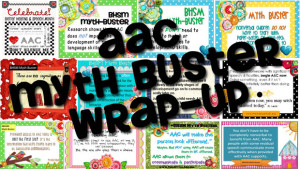
It stings to write this, but the truth is that in our country, students studying to become SLPs can graduate with little to no experience in AAC. While we’ve made some progress in getting more AAC into university SLP programs here in the US, we’ve really only scratched the surface. Given that a great many graduate without sufficient AAC knowledge, ASHA’s 2013 Better Speech and Hearing Month seemed like a perfect time to reach out to people who are relatively new in the field. I’m fairly certain that Dr. Lyle Lloyd, my doctoral advisor at Purdue University, was the first to talk about the mythology surrounding AAC, but many have followed that tradition. In a perfect world, we would have pre-planned our own myth busters and released them with pizazz in some sort of ordered fashion. But there was therapy to provide, student SLPs to teach, parents to talk to,... [Read More...]
Filed under: PrAACtical Thinking
Tagged With: ASHA, BSHM, download, myths
December 16, 2012
by Carole Zangari -
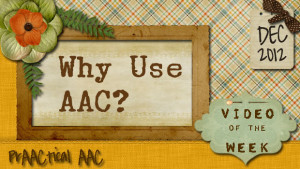
Do you work with colleagues and families who have concerns about using AAC? Get questions about whether AAC is really necessary? Overhear remarks about not wanting to “give up on speech?” So do we. We’ve planned a few screencasts to help in addressing these issues. Here’s the first one.
Filed under: Video of the Week
Tagged With: clinical rationale, concerns, evidence, giving up on speech, intervention, myths, research support, speech only
October 13, 2012
by Robin Parker -
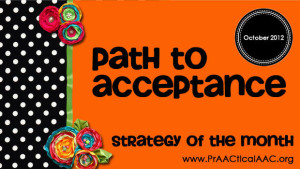
“Attitude is a little thing that makes a big difference”- Winston Churchill October’s Strategy of the Month focuses on Acceptance of AAC. There is always a path to acceptance of new ideas, new situations, or even new science. Even though AAC strategies and concepts are by no means new, they are often different from the ‘norm’ (whatever that is). We know that the path to acceptance is often filled with obstacles. In AAC, The Participation Model (Beukelman & Mirenda, 1988) delineates two main barriers to successful implementation. There are opportunity and access barriers. Opportunity barriers to participation are those imposed by people in the environment of the AAC user, while access barriers are present based on issues related to the individual who uses AAC. It seems that in the last several school and community visits, we have noticed a high degree of opportunity barriers which relate to attitude. The attitude... [Read More...]
Filed under: Strategy of the Month
Tagged With: AAC Acceptance, AAC Awareness, myths
April 30, 2012
by Robin Parker -

Nooooo, not again. A myth about visual schedules continues to rear its ugly head in a prAACtical situation (maybe we can reframe it into a learning opportunity??). Some history- A parent of twin girls with autism (age 15 and two other younger children– yes total 4) stopped by our office to pick up some autism awareness materials yesterday (a super busy mom in so many ways —going out of her way to help our community). As we were exchanging pleasantries and getting updates on how the girls were doing, we heard something that continues to surprise us–(and not in a good way). What did we hear? We heard that the girls were doing relatively well (not the surprising comment) but that mom was extra busy because the girls were no longer independent in taking their showers. They could do it by themselves but didn’t like the sensory input of soap... [Read More...]
Filed under: PrAACtical Thinking
Tagged With: mini schedules, myths, schedules, visual supports





